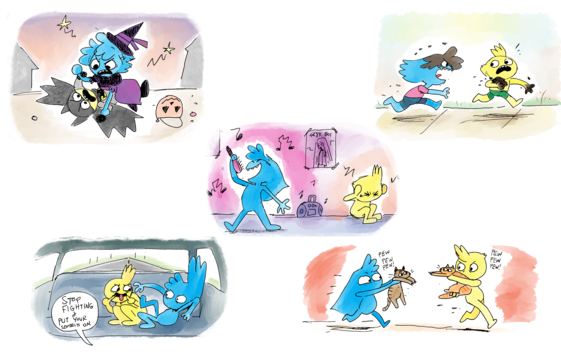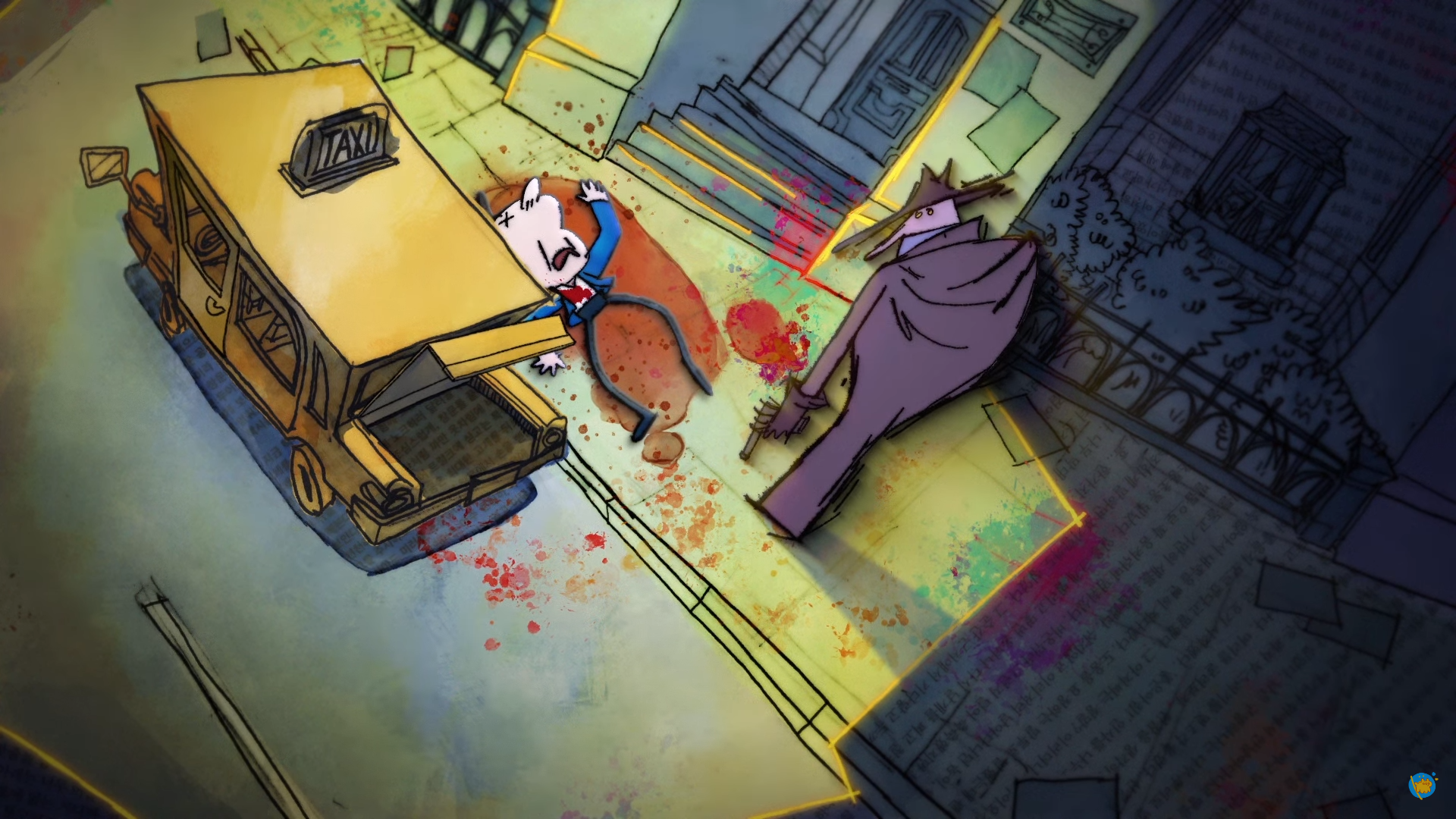Two
Directed by LINDSAY SCANLAN
United States of America, 2020
Drama, Comedy
The story of a child named Blue. Her twin was Yellow. Together, they were two.
Read our interview with Lindsay below to learn more about the film.
LINDSAY SCANLAN
Est. Reading Time: 7 Minutes
MARK (M) Tell us a little about yourself - when did you become interested in film and filmmaking? And what made you particularly interested in animation?
LINDSAY (L) I’m not certain when to exactly pinpoint my interest in filmmaking itself as for the longest time, I first considered myself an artist. I would make little cheap comic books with my brother out of construction paper and copy paper which would end up scattered all around the house. Until I went to school for a degree, I didn’t think too much about how animation was related to filmmaking, I saw it more so as visual art that I really enjoyed doing. CalArts is probably where I learned more about the ‘laws’ of filmmaking and cinematography which I have then implemented into my artistry.
Around my sixth or seventh birthday, my friend gave me a VHS copy of Studio Ghibli’s My Neighbor Totoro (1988). It was so weird and different compared to the Disney movies I was used to seeing in both style and substance, and ye gods I was hooked. It opened my eyes to a world of creativity and visual storytelling I had never seen before, and I knew there was no way I was ever going to get it out of my head.
M Why are you interested in making films?
L Aside from being an artist, I consider myself a storyteller - be it through comics, story beats, written or spoken word, I like coming up with different characters in different situations and engaging with an audience. Filmmaking is a natural vessel for this sort of thing, and if I can animate it, that is a plus. I try to tell stories I have experienced or those that I think are relatable, and get a reaction from the people I share them with.
On Specificity
M I really love how you depict Blue and Yellow’s relationship through small and distinct moments/vignettes. One of my favourite sequences is when Blue and Yellow fight over sitting close to the television - it’s brilliant!
I know the film is strongly based upon your relationship with your twin brother but can you please provide a little more insight into the specificity of each vignette - how much was based upon very specific childhood experiences and memories?
L That particular vignette was more or less a conglomerate of the several times that we were told not to sit close to the television because it would hurt our eyes. We would inadvertently ignore it because we took turns trying to get in each other’s space. As a kid, if you were a twin like I was, there was nothing more time-killing than asserting dominance over your sibling by annoying the crap out of them.
Almost all the vignettes were based on various childhood memories in one way or another (like the matching Barney the Dinosaur costumes at Halloween). The most I diverted from reality was Yellow and Blue sharing a room. My brother and I actually had separate rooms growing up but for the sake of sparing ‘shoe leather’ and keeping the cinematography simple, I put the two characters in the same room.
M How many different types of vignettes did you come up with before deciding to focus on the ones that we see in the film? Please tell us about the evolution of the script - how did it change during production and/or post-production?
L There were a lot of vignettes I had written down or scribbled before I got to the storyboarding process, and most were cut pretty early to save time or keep the focus on the twins. I thought about implementing the school and social environments my brother and I each had as kids, but I ultimately decided to limit the amount of characters who would be involved in the story and focus exclusively on Yellow and Blue’s relationship with each other. Adding parents or school friends would have made the story way too long and interwoven for a 5-7 minute film that I had to animate by myself in less than one year.
Surprisingly, the first draft of the script and storyboards stayed pretty consistent from start to finish. My film workshop, led by Fran Krause was immensely supportive of my first pitch and reacted incredibly well. Most of the changes that were made were cinematic staging changes or cutting shots here and there. There was also one scene involving birthday candles being blown out to parallel the ‘cord’ being cut but I ultimately decided not to include it as it seemed redundant. I did however keep the shots of the twins celebrating their birthdays in the final product.
On Comedic Timing
M I really like how you use pacing and rhythm for comedic effect within each scene. Please tell us about your approach to comedic timing - is it mainly instinctive, or does it require lots of practise/trial-and-error to establish the right pacing and flow in each scene?
L I approach comedic timing on a case-by-case basis. For the majority of this project, I approached it the same way the filmmaker Don Hertzfeldt did in some of his older films where the characters are allowed to silently take in the situation they are put in, and allow for plenty of awkward pauses and uncomfortable silences before someone punches someone else in the face or something spontaneous breaks the silence. This sort of approach requires a lot of trial-and-error, I would spend hours deleting or adding frames trying to decide if a shot was running for too long or too short. The uncomfortable awkward silences and staring are funny until the audience gets bored and I was careful in making sure that was not going to happen.
‘I try to tell stories I have experienced or those that I think are relatable, and get a reaction from the people I share them with’
— Lindsay Scanlan
On Inspiration
M What are some of the films and who are some of the filmmakers that inspire you, and why?
L As I mentioned above, Studio Ghibli and Don Hertzfeldt are both pretty big influences. I think I am ultimately more inspired by dual artists and writers (Like Allie Brosh or Jon Klassen) than straight-up filmmakers, but a lot of the artists I admire are workers in the animation industry such as Shiyoon Kim and Lisa Hanawalt. I am a huge fan of Tove Jansson’s work, especially The Moomins (1977-1982) and how she was able to create stories that had the childlike charm and whimsy that appeals to children, but also have a strange somber aura to them. Her artistry was incomparable to anyone else and her use of visual language in her comic strips has stuck with me for years and years.
Rejected (2000) by Don Hertzfeldt
On The Future
M What are you planning to make next?
L I would definitely like to try to complete another film in the next couple of years, or at the very least, do some animation projects for the fun of it. My priority right now is to take on as much freelance work or studio work as I can, build up my resume and pay the bills. It’s kind of tricky as a post-graduate in a pandemic-stricken world to find animation work, but I’m getting by as much as I can.
My other filmmaking goal is to not die. Dying can really put a wrench in the filmmaking process.
Mark’s Final Thoughts
Interesting to learn that the specific type of Halloween costume worn by the twins was directly taken from her childhood. I think this example really typifies the film's strong level of authenticity and detail.
Lindsay's thoughts about comedic timing demonstrate her strong instincts as a storyteller - I really like the fact that she was able to successfully navigate the negative aspects of repetition through slightly altering the structure of certain vignettes and introducing unique ideas to make the narrative less predictable and more engaging for the audience.
And I can imagine the difficulty of trying to complete your thesis project in the middle of a pandemic, I think Lindsay did a great job in not letting adverse circumstances affect her ability to create a distinct film.
Tags Animation Bourgeon Family
Want to Learn More? Click here for Lindsay’s thoughts about the symbolism of umbilical cords as well as her brother’s reaction to the film.
The founder of Hommage, Mark Shaba published this interview on 08.02.2022. Mark is a grassroots filmmaker from Victoria, Australia. He respectfully acknowledges the past and present traditional owners of the land on which he creates, promotes and screens art, the Wurundjeri people of the Kulin nation who are the custodians.


























